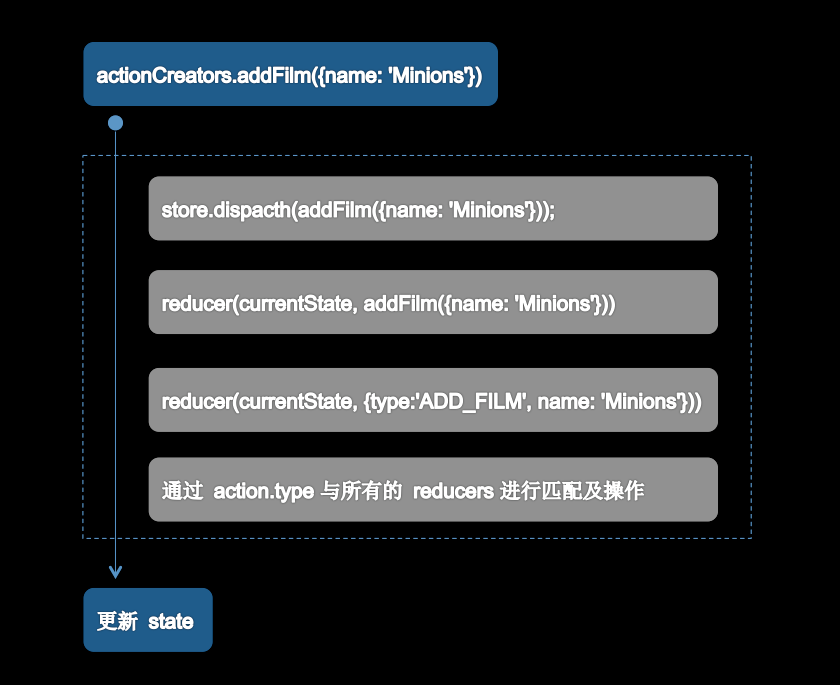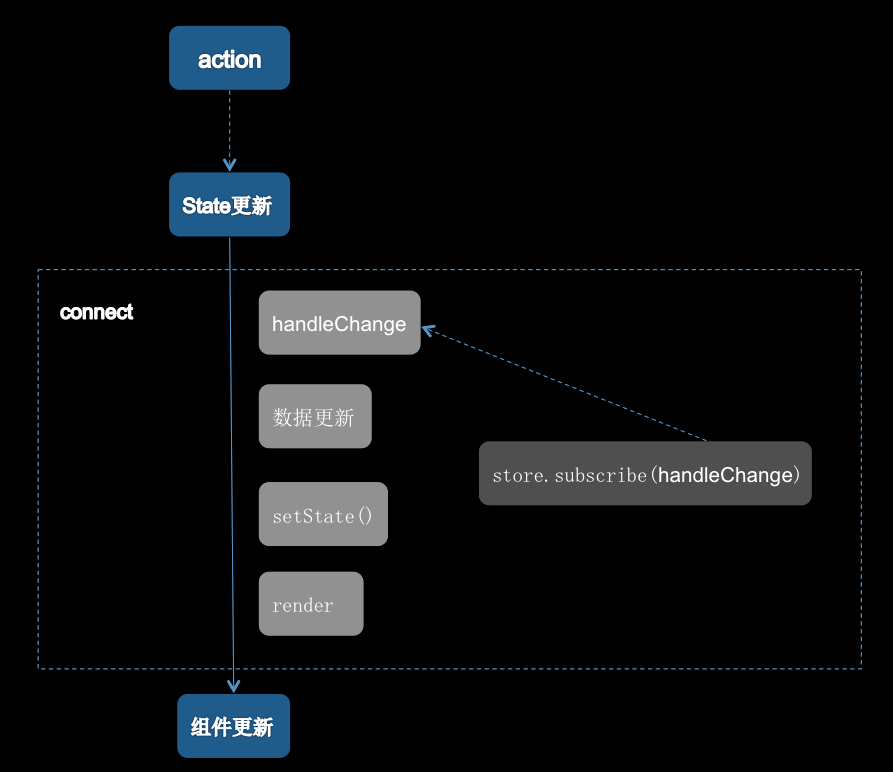React 数据流管理架构之 Redux 介绍
继 Facebook 提出 Flux 架构来管理 React 数据流后,相关架构开始百花齐放,本文简单分析 React 中管理数据流的方式,以及对 Redux 进行较为仔细的介绍。
React
" A JAVASCRIPT LIBRARY FOR BUILDING USER INTERFACES "
在 React 中,UI 以组件的形式来搭建,组件之间可以嵌套组合。另,React 中组件间通信的数据流是单向的,顶层组件可以通过 props 属性向下层组件传递数据,而下层组件不能向上层组件传递数据,兄弟组件之间同样不能。这样简单的单向数据流支撑起了 React 中的数据可控性。
那么,更全面的组件间通信形式该怎么实现呢?
-
嵌套组件间,上层组件向下层组件传递回调函数,下层组件触发回调来更新上层组件的数据。
-
以事件的形式,使用发布订阅的方式来通知数据更新。
-
Flux —- Fackbook 提出的管理 React 数据流的架构。Flux 不像一个框架,更是一种组织代码的推荐思想。就像 “引导数据流流向的导流管”。
-
其他的 “导流管”。ReFlux,Redux 等。
前两种形式其实也足够在小应用中跑起来。但当项目越来越大的时候,管理数据的事件或回调函数将越来越多,也将越来越不好管理了。 对于后两种形式,个人经过对比后,可以看出 Redux 对 Flux 架构的一些简化。如 Redux 限定一个应用中只能有单一的 store,这样的限定能够让应用中数据结果集中化,提高可控性。当然,不仅如此。
Redux
Redux 主要分为三个部分 Action、Reducer、及 Store
Action
在 Redux 中,action 主要用来传递操作 State 的信息,以 Javascript Plain Object 的形式存在,如
{
type: 'ADD_FILM',
name: 'Mission: Impossible'
}
在上面的 Plain Object 中,type 属性是必要的,除了 type 字段外,action 对象的结构完全取决于你,建议尽可能简单。type 一般用来表达处理 state 数据的方式。如上面的 'ADD_FILM' 表达要增加一个电影。而 name 表达了增加这个电影的电影名为 'Mission: Impossible'。那么,当我们需要表达增加另一部电影时,就需要另外一个action,如
{
type: 'ADD_FILM',
name: 'Minions'
}
上面写法没有任何问题,但细想,当我们增加的电影越来越多的时候,那这种直接声明的 Plain Object 将越来越多,不好组织。实际上,我们可以通过创建函数来生产 action,这类函数统称为 Action Creator,如
function addFilm(name) {
return { type: 'ADD_FILM', name: name };
}
这样,通过调用 addFilm(name) 就可以得到对应的 Action,非常直接。
Reducer
有了 Action 来传达需要操作的信息,那么就需要有根据这个信息来做对应操作的方法,这就是 Reducer。 Reducer 一般为简单的处理函数,通过传入旧的 state 和指示操作的 action 来更新 state,如
function films(state = initialState, action) {
switch (action.type) {
case 'ADD_FILM':
// 更新 state 中的 films 字段
return [{
id: state.films.reduce((maxId, film) => Math.max(film.id, maxId), -1) + 1,
name: action.name
}, ...state];
case 'DELETE_FILM':
return state.films.filter(film =>
film.id !== action.id
);
case 'SHOW_ALL_FILM':
return Object.assign({}, state, {
visibilityFilter: action.filter
});
default:
return state;
}
上面代码展示了 Reducer 根据传入的 action.type 来匹配 case 进行不同的 state 更新。
显然,当项目中存在越来越多的 action.type 时,上面的 films 函数( Reducer )将变得越来越大,越来越多的 case 将导致代码不够清晰。所以在代码组织上,通常会将 Reducer 拆分成一个个小的 reducer,每个 reducer 分别处理 state 中的一部分数据,最终将处理后的数据合并成为整个 state。
在上面的代码中,我们可以把 'ADD_FILM' 和 'DELETE_FILM' 归为操作 state.films 的类,而 'SHOW_ALL_FILM' 为过滤显示类,所以可以把大的 film Reducer 拆分成 filmReducer 和 filterReducer,如
1 filmReducer
function filmReducer(state = [], action) {
switch (action.type) {
case 'ADD_FILM':
// 更新 state 中的 films 字段
return [{
id: state.films.reduce((maxId, film) => Math.max(film.id, maxId), -1) + 1,
name: action.name
}, ...state];
case 'DELETE_FILM':
return state.films.filter(film =>
film.id !== action.id
);
default:
return state;
}
}
2 filterReducer
function filterReducer(state, action) {
switch (action.type) {
case 'SHOW_ALL_FILM':
return Object.assign({}, state, {
visibilityFilter: action.filter
});
default:
return state;
}
}
最后,通过组合函数将上面两个 reducers 组合起来,如
function rootReducer(state = {}, action) {
return {
films: filmReducer(state.films, action),
filter: filterReducer(state.filter, action)
};
}
上面的 rootReducer 将不同部分的 state 传给对应的 reducer 处理,最终合并所有 reducer 的返回值,组成整个state。
实际上,Redux 提供了 combineReducers() 方法来做 rootReducer 所做的事情。使用 combineReducers 来重构 rootReducer,如
var rootReducer = combineReducers({
films: filmReducer,
filter: filterReducer
});
combineReducers() 将调用一系列 reducer,并根据对应的 key 来筛选出 state 中的一部分数据给相应的 reducer,这样也意味着每一个小的 reducer 将只能处理 state 的一部分数据,如:filterReducer 将只能处理及返回 state.filter 的数据,如果需要使用到其他 state 数据,那还是需要为这类 reducer 传入整个 state。
在 Redux 中,一个 action 可以触发多个 reducer,一个 reducer 中也可以包含多种 action.type 的处理。属于多对多的关系。
Store
回顾 Action 及 Reducer:
Action 用来表达操作消息,Reducer 根据 Action 来更新 State。
在 Redux 项目中,Store 是单一的。维护着一个全局的 State,并且根据 Action 来进行事件分发处理 State。可以看出 Store 是一个把 Action 和 Reducer 结合起来的对象。
Redux 提供了 createStore() 方法来 生产 Store,并提供三个 API,如
var store = createStore(rootReducer); // 其中 rootReducer 为顶级的 Reducer
store 对象可以简单的理解为如下形式
function createStore(reducer, initialState) {
//闭包私有变量
var currentReducer = reducer;
var currentState = initialState;
var listeners = [];
function getState() {
return currentState;
}
function subscribe(listener) {
listeners.push(listener);
return function unsubscribe() {
var index = listeners.indexOf(listener);
listeners.splice(index, 1);
};
}
function dispatch(action) {
currentState = currentReducer(currentState, action);
listeners.slice().forEach(listener => listener());
return action;
}
//返回一个包含可访问闭包变量的公有方法
return {
dispatch,
subscribe,
getState
};
}
store.getState() 用来获取 state 数据。
store.subscribe(listener) 用于注册监听函数。每当 state 数据更新时,将会触发监听函数。
而 store.dispatch(action) 是用于将一个 action 对象发送给 reducer 进行处理。如
store.dispatch({
type: 'ADD_FILM',
name: 'Mission: Impossible'
});
store 对象使得我们可以通过 store.dispatch(action) 来减少对 reducer 的直接调用,并且能够更好地对 state 进行统一管理。没有 store,可能会出现 reducer(currentState, action) 这样的频繁地传入 state 参数的更新形式。
bindActionCreators
从上面的 Action 相关介绍中可知,我们使用了 ActionCreator 来生产 action。所以在实际的 store.dispatch(action) 中,我们需要这样调用 store.dispatch(actionCreator(…args))。
借鉴 Store 对 reducer 的封装(减少传入 state 参数)。可以对 store.dispatch 进行再一层封装,将多参数转化为单参数的形式。 Redux 提供的 bindActionCreators 就做了这件事。如
var actionCreators = bindActionCreators(actionCreators, store.dispatch);
现在,经 bindActionCreators 包装过后的 action Creator 形成了具有改变全局 state 数据的多个函数,将这些函数分发到各个地方,即能通过调用这些函数来改变全局的 state。
Redux 中的函数传递及原理
当调用了具备操作全局 state 的函数时,将经过一系列的函数传递及调用,如
问:为什么不直接使用 reducer(currentState, {type:'ADD_FILM', name: 'Minions'})) 呢?
答:这样做除了在代码组织和扩展维护上提供了便利,同时也涵盖了函数式编程的许多优点。
React-Redux
Redux 并不依赖于 React,它支持多种框架 Ember、Angular、jQuery 甚至纯 JavaScript。但实际上,它更合适由 数据更新 UI 的框架。如 React、Deku。
上面的章节最终通过 bindActionCreators 得到具有操作全局 state 的函数集合,在与 React 搭配时,就会将这些函数分发到各个对应的组件中,从而组件具备了操作全局的 state 的功能。在上节中可以得到,调用操作全局 state 的函数,最终将更新 state。当 redux 与 react 结合,在更新 state 时,将会触发 重新渲染 组件的函数,进而组件得到更新。
react-redux 主要提供两个组件来实现上述功能。
Connect
Connect 组件主要为 React 组件提供 store 中的部分 state 数据 及 dispatch 方法,这样 React 组件就可以通过 dispatch 来更新全局 state。在 React 组件中,如果你希望让组件通过调用函数来更新 state,可以通过使用 const actions = bindActionCreators(FilmActions, dispatch); 将 actions 和 dispatch 揉在一起,成为具备操作 store.state 的 actions。最终将 actions 和 state(state.films)以 props 形式传入子组件中。如
import { connect } from 'react-redux';
import * as addFlim from '../actions/films';
// 其他模块引入..
class FilmApp extends Component {
render() {
// 从 react-redux 注入
const { todos, dispatch } = this.props;
// 生成具有操作 state 能力的 actions
const actions = bindActionCreators(FilmActions, dispatch);
// 为各个 React 组件提供 state 数据 及 actions
return (
<div>
<Header films={films} actions={actions}/>
<Section films={films} deleteFilm={actions.deleteFilm}/>
</div>
);
}
}
// state 将由 store 提供
function select(state) {
return {
films: state.films
};
}
// 最终暴露 经 connect 处理后的组件
export default connect(select)(FilmApp);
由上,在 redux 提供的 connect 函数中,select 函数用于筛选 state 的部分数据,最终和 dispatch 以 props 的形式传给 React 组件(FilmApp)。FilmApp 就可通过 this.props 来得到 store 中的 state 及 dispatch。
在 redux 中,没有与 redux 有直接关联的组件称为木偶组件,如 FilmApp 下的子组件,不理外面纷纷扰扰,只知道自己拥有了 state 及 具备操作 state 数据的 actions 方法。
当木偶组件使用 actions 方法,更新了 store.state 的数据时,将会触发 store 中的 subscribe 所注册的函数。而其中一个注册函数,就在 Connect 组件中静默注册了。
// 在 Connect 中 this.store.subscribe(this.handleChange.bind(this));
即当 actions 更改了 state 时,会调用注册函数 handleChange。从而进行 “阿米诺骨牌式” 的函数执行连锁反应。更新了 state,并使用新的数据重新 render 组件。实际上是为智能组件 FilmApp(传入 connect 的组件)传入新的 props,因为各个子元素是通过引用父级组件的 props,所以将进行一级一级的差异数据更新,最终效果就是页面更新了。
实际上,这里与简单的发布订阅模式类似。使用 store.subscribe(cb); 来订阅一个回调函数,子组件进行 action 操作 store.state 时进行发布,执行了回调函数。
在 react-redux 中,数据的流向及对应的反应,如
Provider
Connect 组件需要 store。这个需求由 Redux 提供的另一个组件 Provider 来提供。源码中,Provider 继承了 React.Component,所以可以以 React 组件的形式来为 Provider 注入 store,从而使得其子组件能够在上下文中得到 store 对象。如
<Provider store={store}>
{() => <FilmApp /> }
</Provider>
在 React 0.13 及以前的版本中,Provider 渲染子组件是通过执行 children(),如
Provider.prototype.render = function render() {
var children = this.props.children;
return children();
};
所以在 React 0.13 及以前的版本中,Provider 的子组件必须是一个函数。这个问题在 React 0.14 中修复。
更多
编辑状态的实时预览 redux-dev-tools https://github.com/gaearon/redux-devtools
大量的相关参考 awesome-redux https://github.com/xgrommx/awesome-redux

